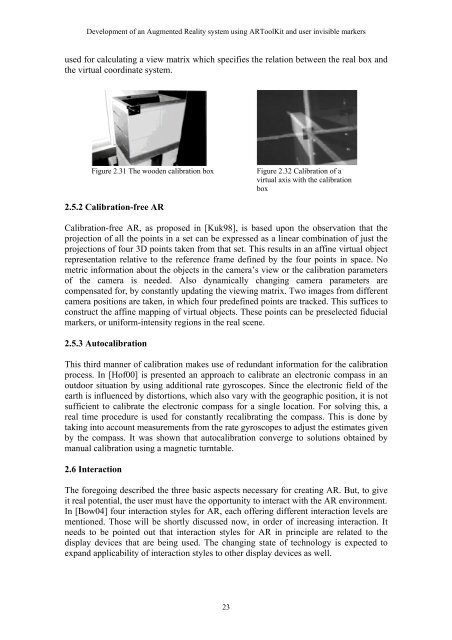Development of an Augmented Reality system using ARToolKit
Development of an Augmented Reality system using ARToolKit
Development of an Augmented Reality system using ARToolKit
You also want an ePaper? Increase the reach of your titles
YUMPU automatically turns print PDFs into web optimized ePapers that Google loves.
<strong>Development</strong> <strong>of</strong> <strong>an</strong> <strong>Augmented</strong> <strong>Reality</strong> <strong>system</strong> <strong>using</strong> <strong>ARToolKit</strong> <strong>an</strong>d user invisible markers<br />
used for calculating a view matrix which specifies the relation between the real box <strong>an</strong>d<br />
the virtual coordinate <strong>system</strong>.<br />
Figure 2.31 The wooden calibration box Figure 2.32 Calibration <strong>of</strong> a<br />
virtual axis with the calibration<br />
box<br />
2.5.2 Calibration-free AR<br />
Calibration-free AR, as proposed in [Kuk98], is based upon the observation that the<br />
projection <strong>of</strong> all the points in a set c<strong>an</strong> be expressed as a linear combination <strong>of</strong> just the<br />
projections <strong>of</strong> four 3D points taken from that set. This results in <strong>an</strong> affine virtual object<br />
representation relative to the reference frame defined by the four points in space. No<br />
metric information about the objects in the camera’s view or the calibration parameters<br />
<strong>of</strong> the camera is needed. Also dynamically ch<strong>an</strong>ging camera parameters are<br />
compensated for, by const<strong>an</strong>tly updating the viewing matrix. Two images from different<br />
camera positions are taken, in which four predefined points are tracked. This suffices to<br />
construct the affine mapping <strong>of</strong> virtual objects. These points c<strong>an</strong> be preselected fiducial<br />
markers, or uniform-intensity regions in the real scene.<br />
2.5.3 Autocalibration<br />
This third m<strong>an</strong>ner <strong>of</strong> calibration makes use <strong>of</strong> redund<strong>an</strong>t information for the calibration<br />
process. In [H<strong>of</strong>00] is presented <strong>an</strong> approach to calibrate <strong>an</strong> electronic compass in <strong>an</strong><br />
outdoor situation by <strong>using</strong> additional rate gyroscopes. Since the electronic field <strong>of</strong> the<br />
earth is influenced by distortions, which also vary with the geographic position, it is not<br />
sufficient to calibrate the electronic compass for a single location. For solving this, a<br />
real time procedure is used for const<strong>an</strong>tly recalibrating the compass. This is done by<br />
taking into account measurements from the rate gyroscopes to adjust the estimates given<br />
by the compass. It was shown that autocalibration converge to solutions obtained by<br />
m<strong>an</strong>ual calibration <strong>using</strong> a magnetic turntable.<br />
2.6 Interaction<br />
The foregoing described the three basic aspects necessary for creating AR. But, to give<br />
it real potential, the user must have the opportunity to interact with the AR environment.<br />
In [Bow04] four interaction styles for AR, each <strong>of</strong>fering different interaction levels are<br />
mentioned. Those will be shortly discussed now, in order <strong>of</strong> increasing interaction. It<br />
needs to be pointed out that interaction styles for AR in principle are related to the<br />
display devices that are being used. The ch<strong>an</strong>ging state <strong>of</strong> technology is expected to<br />
exp<strong>an</strong>d applicability <strong>of</strong> interaction styles to other display devices as well.<br />
23
















